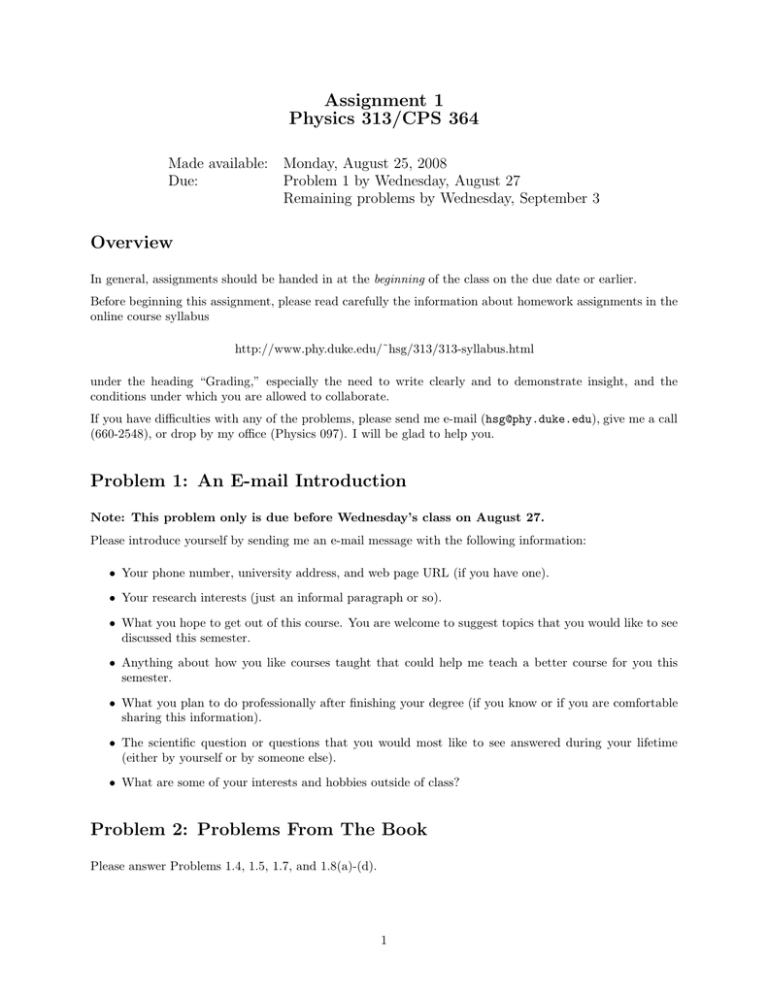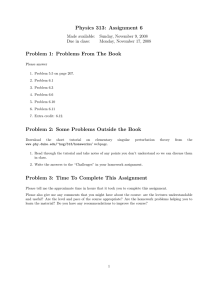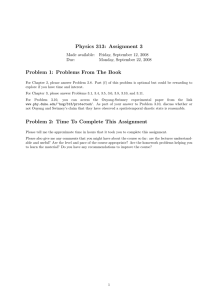Assignment 1 Physics 313/CPS 364
advertisement

Assignment 1 Physics 313/CPS 364 Made available: Due: Monday, August 25, 2008 Problem 1 by Wednesday, August 27 Remaining problems by Wednesday, September 3 Overview In general, assignments should be handed in at the beginning of the class on the due date or earlier. Before beginning this assignment, please read carefully the information about homework assignments in the online course syllabus http://www.phy.duke.edu/˜hsg/313/313-syllabus.html under the heading “Grading,” especially the need to write clearly and to demonstrate insight, and the conditions under which you are allowed to collaborate. If you have difficulties with any of the problems, please send me e-mail (hsg@phy.duke.edu), give me a call (660-2548), or drop by my office (Physics 097). I will be glad to help you. Problem 1: An E-mail Introduction Note: This problem only is due before Wednesday’s class on August 27. Please introduce yourself by sending me an e-mail message with the following information: • Your phone number, university address, and web page URL (if you have one). • Your research interests (just an informal paragraph or so). • What you hope to get out of this course. You are welcome to suggest topics that you would like to see discussed this semester. • Anything about how you like courses taught that could help me teach a better course for you this semester. • What you plan to do professionally after finishing your degree (if you know or if you are comfortable sharing this information). • The scientific question or questions that you would most like to see answered during your lifetime (either by yourself or by someone else). • What are some of your interests and hobbies outside of class? Problem 2: Problems From The Book Please answer Problems 1.4, 1.5, 1.7, and 1.8(a)-(d). 1 Problem 3: A Review Problem: Criterion for Linear Stability of a Marginally Unstable Fixed Point 1. Consider the one-dimensional ordinary differential equation (abbreviated as “o.d.e.”) du = f (u), dt (1) that is an evolution equation for the variable u(t) and where the function f (u) is smooth (continuous with continuous first derivative, a reasonable assumption for many equations describing natural systems). Let u∗ be a fixed point of Eq. (1) so that f (u∗ ) = 0. (2) Then you know from your prerequisite nonlinear dynamics course that this fixed point is linearly stable provided that f ′ (u∗ ) < 0, (3) in which case any infinitesimal perturbation δu(t) of the fixed point u∗ will decay over time. Assume now that some parameter of this system is tuned so that the fixed point u∗ becomes marginally stable, which means that f ′ (u∗ ) = 0. (4) (a) Assuming that f ′′ (u∗ ) 6= 0, determine under what conditions this marginally stable fixed point is linearly stable or not. Hint: An infinitesimal perturbation of the fixed point is a solution u(t) = δu(t) + u∗ of Eq. (1) such that δu is infinitesimal in magnitude. Substitute this expression into Eq. (1), expand to an appropriate order in some Taylor series, and then think. (b) By inventing suitable simple mathematical odes such that a fixed point becomes marginally stable as some parameter is verified, test analytically or by a numerical integration (e.g., with Mathematica or Matlab) that your answer for the linear stability of a marginally stable fixed point is correct. 2. Now consider the similar question of how to determine the linear stability of a fixed point u∗ of some one-dimensional map un+1 = g(un ), where g(u) is some smooth function. Assuming that g ′′ (u∗ ) 6= 0, derive a condition for linear stability of a marginally stable fixed point. Again verify the correctness of your result by inventing an appropriate map (or maps) with a marginally stable fixed point and by testing your criterion directly by numerical iteration. Note: The criterion for u∗ to be a fixed point is now u∗ = g(u∗ ) and the criterion for the fixed point to be marginally stable is that |g ′ (u∗ )| = 1. Unlike your above discussion for an ode, you will need to consider two different cases, first that g ′ (u∗ ) = 1 and second that g ′ (u∗ ) = −1. With some thinking, you should be able to find a way to reduce the second case to the first case. Your final answers will be some inequality that involves g and several of its derivatives all evaluated at the fixed point. Problem 4: Time To Complete This Assignment Please tell me the approximate time in hours that it took you to complete this assignment. 2








